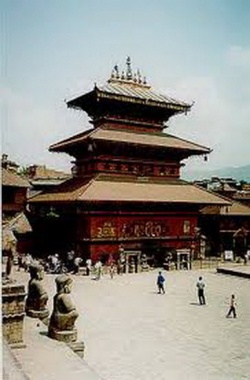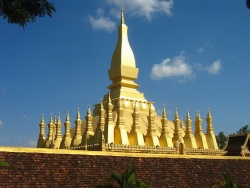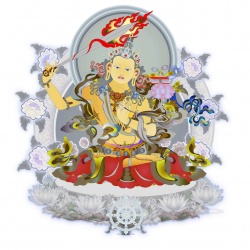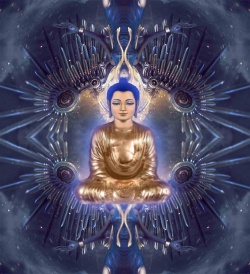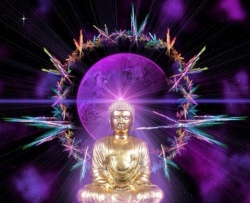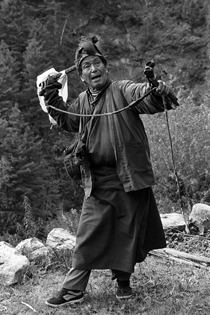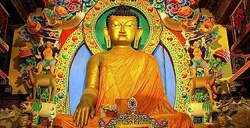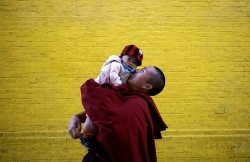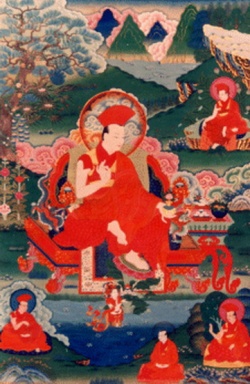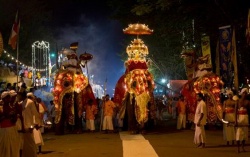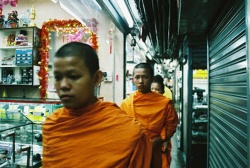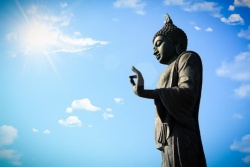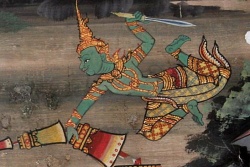Difference between revisions of "Buddhism and the Karma Kamtsang"
(Created page with " Buddhism and the Karma Kamtsang Tibetan Buddhist Tradition What is a Buddha? A Buddha is someone who realises (i.e. makes real) the Wikipedia:Abs...") |
|||
| Line 1: | Line 1: | ||
| − | + | <nomobile>{{DisplayImages|2720|806|79|4339|4252|500|1107|418|2110|1702|2107|2729|2067|103|276}}</nomobile> | |
| Line 10: | Line 10: | ||
What is a [[Buddha]]? | What is a [[Buddha]]? | ||
| − | A [[Buddha]] is someone who realises (i.e. makes real) the [[Wikipedia:Absolute (philosophy)|ultimate]] potential of the [[mind]]. Therefore, one day or another, we may all become [[Buddhas]]. The [[Wikipedia:Absolute (philosophy)|ultimate]] potential is a [[state]] of total, [[unlimited]] clarity, that [[knows]] everyone and everything. It is [[inseparable]] from an [[infinite]], [[universal love]] and [[compassion]] and endowed with tremendous power to help others whose [[minds]] are open. | + | A [[Buddha]] is someone who realises (i.e. makes real) the [[Wikipedia:Absolute (philosophy)|ultimate]] potential of the [[mind]]. |
| + | |||
| + | Therefore, one day or another, we may all become [[Buddhas]]. The [[Wikipedia:Absolute (philosophy)|ultimate]] potential is a [[state]] of total, [[unlimited]] clarity, that [[knows]] everyone and everything. | ||
| + | |||
| + | It is [[inseparable]] from an [[infinite]], [[universal love]] and [[compassion]] and endowed with tremendous power to help others whose [[minds]] are open. | ||
| − | |||
| − | + | The journey to this [[Wikipedia:Absolute (philosophy)|ultimate]] [[state]] involves freeing the [[mind]] from its grosser limitations, such as [[anger]], [[selfish]] [[desire]], [[pride]] etc., and also its {{Wiki|subtle}} limitations, mainly consisting of [[conditioned]] [[thought]]- patterns of [[dualistic perception]] (subject-object, me-you, mind-body etc.). | |
| − | General - the [[Buddha]] and | + | Someone who completes this journey of [[liberation]], perfectly, is a [[Buddha]]. Such was [[Sakyamuni]], who achieved his [[total enlightenment]] over 2,500 years ago, in [[India]]. |
| + | |||
| + | |||
| + | Through the great clarity of his [[mind]], he [[taught]] the [[universal truths]] of [[existence]], in their entirety. | ||
| + | |||
| + | There are [[thought]] to be 1,002 such [[teaching]] [[Buddhas]] during the [[lifetime]] of our {{Wiki|solar system}}. | ||
| + | |||
| + | [[Sakyamuni]] was the fourth. | ||
| + | |||
| + | |||
| + | |||
| + | ==General - the [[Buddha and His Teaching]]== | ||
| + | |||
| + | |||
| + | |||
| + | A [[Buddha]] is not a saviour but a [[teacher]]. His teachings ("[[dharma]]") show us what to do in order to achieve the same [[state]] that he achieved. | ||
| + | |||
| + | The [[dharma]] is perpetuated through the ages, as a living [[tradition]] of [[enlightened]] [[experience]] and as a [[philosophy]], by those members of the [[Buddhist community]] who have themselves already achieved unmistakable [[insight]]. | ||
| + | |||
| + | |||
| + | These are known as the realized [[sangha]]. | ||
| + | |||
| + | |||
| + | The [[Buddha's teachings]] spread from [[India]] throughout {{Wiki|Asia}}, even reaching as far as {{Wiki|Greece}} at one point ([[Buddhist]] {{Wiki|Greek}} {{Wiki|monarch}} - [[Melinder]]). | ||
| + | |||
| + | They reached what are today [[Japan]], {{Wiki|Indonesia}}, [[Mongolia]] and [[Russia]], and countries (such as [[China]], [[Burma]] etc.) on the way from [[India]] to these continental extremities. Today they are to be found throughout the [[world]]. | ||
| − | |||
| − | |||
The teachings themselves are addressed to 3 different audiences: | The teachings themselves are addressed to 3 different audiences: | ||
| − | ... those wishing to improve their [[worldly | + | ... those wishing to improve their [[worldly experience]], in this [[life]] and [[future lives]], through a better [[understanding]] of the [[causal mechanisms of existence]]. |
| + | |||
| + | |||
... those who recognise the limited, anguished [[nature]] of [[worldly existence]], wish to free from it forever and who therefore seek a lasting [[peace]] and [[happiness]]. | ... those who recognise the limited, anguished [[nature]] of [[worldly existence]], wish to free from it forever and who therefore seek a lasting [[peace]] and [[happiness]]. | ||
| − | |||
| − | |||
| − | ... the [[hinayana]] - the first two audiences mentioned above. The | + | ... those who want not just the [[peace]] and [[happiness]] of [[liberation]] from [[worldly suffering]], but all the {{Wiki|myriad}} qualities {{Wiki|present}} in [[total enlightenment]]. |
| + | |||
| + | These qualities enable great [[benefit]] for all other [[forms]] of [[conscious]] [[life]], as we can see from the [[life]] of [[Sakyamuni Buddha]]. | ||
| + | |||
| + | Each of us is unique. We have different needs and different [[aspirations]]. | ||
| + | |||
| + | Among those who [[benefit]] from practising the [[Buddhist meditation]] techniques and way of [[life]], one can distinguish three major capacities (yãna): | ||
| + | |||
| + | |||
| + | |||
| + | ... the [[hinayana]] - the first two audiences mentioned above. | ||
| + | |||
| + | The key-points of their [[spiritual path]] are [[non- violence]], [[pure ethics]] and [[meditation]] (mainly [[concentration meditation]]). | ||
| + | |||
| + | |||
... the [[mahayana]] - the third audience. Their [[path]], which has a broader [[ethical]] [[dimension]] and a wider and deeper scope of [[meditation]], is underpinned at all times by a [[compassionate]] longing to achieve the [[Wikipedia:Absolute (philosophy)|ultimate]] potential of one's [[own]] [[existence]] in order to be truly capable of helping others. | ... the [[mahayana]] - the third audience. Their [[path]], which has a broader [[ethical]] [[dimension]] and a wider and deeper scope of [[meditation]], is underpinned at all times by a [[compassionate]] longing to achieve the [[Wikipedia:Absolute (philosophy)|ultimate]] potential of one's [[own]] [[existence]] in order to be truly capable of helping others. | ||
| − | ... the [[vajrayana]] - a special [[development]] of the [[mahayana buddhism]] mentioned above. It is special on account of the very powerful, | + | |
| + | |||
| + | ... the [[vajrayana]] - a special [[development]] of the [[mahayana buddhism]] mentioned above. | ||
| + | |||
| + | |||
| + | It is special on account of the very powerful, customized, [[meditation]] techniques which it employs. | ||
| + | |||
| + | This [[third yana]] can only be applied when an {{Wiki|excellent}} and properly-qualified [[teacher]] (Skt. = [[guru]]) teaches someone who has the required stability and qualities of [[mind]]. | ||
| + | |||
| + | |||
[[Tibetan Buddhism]] | [[Tibetan Buddhism]] | ||
| − | |||
| − | |||
| − | Over the centuries, various major streams of [[Buddhism]] emerged in [[Tibet]]. Although [[Tibetan scholars]] | + | All three aspects of the [[Buddha's teaching]] were perpetuated in [[Tibet]]. There is not really such a thing as "[[Tibetan Buddhism]]", inasmuch as its content is chiefly composed of the [[Buddhism]] flourishing in [[India]] between the 8th - 12th centuries C.E., |
| + | |||
| + | transplanted into [[Tibet]] over those centuries during a great wave of [[activity]] animated by both [[Indian]] and [[Tibetan Buddhist]] [[masters]] (fortunately so, for it was eradicated in its native [[India]] in the centuries which followed). | ||
| + | |||
| + | |||
| + | |||
| + | Although the [[Tibetans]] did an {{Wiki|excellent}} job of codifying and commenting on the [[Buddhism]] of [[India]], they added little to its actual content. | ||
| + | |||
| + | [[Tibetan Buddhism]] should not be seen as some exotic backwater of [[Buddhism]], as some might expect, but as the cream of [[Buddhism]], in its most complete [[form]] found anywhere in the [[world]]. | ||
| + | |||
| + | Within its manifold teachings, one finds all that is found separately elsewhere as [[Theravada]], [[Zen]] etc. as well as many teachings that only remained extant in [[Tibet]]. | ||
| + | |||
| + | |||
| + | |||
| + | Of the three sorts of [[Indian Buddhism]], the [[vajrayana]] (also often referred to as [[tantra]]) survived in a living and integral [[form]] only in [[Tibet]], although some traces of it are found, in a more rarefied and hermetic way, in [[Burma]] and [[Japan]]. | ||
| + | |||
| + | It is the nec plus ultra of [[Buddhism]] and the [[Tibetans]] preserved it in an [[extraordinary]] way. | ||
| + | |||
| + | Almost one in four [[Tibetan]] men was a [[monk]] or [[hermit]], it is said. | ||
| + | |||
| + | A slightly less, but still significant, percentage of the {{Wiki|female}} population were [[nuns]]. | ||
| + | |||
| + | It is through their widespread and diligent [[practice of meditation]] that the "[[inner transmission]]" of the real meaning of the [[Buddha's teachings]] was kept alive and flourishing in [[Tibet]]. | ||
| + | |||
| + | |||
| + | Over the centuries, various major streams of [[Buddhism]] emerged in [[Tibet]]. | ||
| + | |||
| + | |||
| + | Although [[Tibetan scholars]] analyze 8 key currents, many [[people]] today consider there to be [[4 major schools of Tibetan Buddhism]]: the [[Nyingma]], [[Kagyu]], [[Sakya]] and [[Gelug]]. | ||
| + | |||
| + | Of these, the oldest is the [[Nyingma]], founded when [[Buddhism]] was first implanted in [[Tibet]] in the 8th century, and the youngest is the [[Gelug]], dating from around the 14th century, the most well-known present-day figure of which is HH the [[Dalai Lama]]. | ||
| + | |||
| + | |||
The [[Kagyu tradition]] | The [[Kagyu tradition]] | ||
| − | |||
| − | |||
| − | + | The [[Kagyu tradition]], like all [[Wikipedia:Authenticity|authentic]] [[Buddhist]] [[lineages]], has its [[roots]] firmly planted in the [[teachings of the Buddha]]. | |
| + | |||
| + | The central point is always one and the same: how to emerge from the transient ups-and-downs, [[pains]] and limited [[pleasures]] of [[worldly existence]], based in [[illusion]], and find the [[permanent]], [[Wikipedia:Absolute (philosophy)|ultimate]] [[happiness]] which is the [[true nature]] of [[existence]]? [[Illusion]] and [[truth]], [[relative]] and [[Wikipedia:Absolute (philosophy)|ultimate]]. | ||
| + | |||
| + | |||
| + | |||
| + | What distinguishes the [[Kagyu]] from the other [[traditions]] is the way in which the [[Buddha's teaching]] is formulated and the extremely powerful [[meditation]] techniques it employs to enable one to [[experience]] and make real the meaning of the [[Buddha's teaching]]. | ||
| + | |||
| + | The clarity of formulation and vividness of technique arise through a direct and unbroken line of [[teaching]] coming directly from the [[Buddha]]. | ||
| + | |||
| + | This is explained more fully in the page on [[Kagyu]] and the [[spiritual]] inheritance from [[Tilopa]] and its section on the meaning of the [[name]] [[Kagyu]]. | ||
| + | |||
| + | |||
| + | by clinking on the hyperlinked names, in the section that follows, you will find fuller biographical {{Wiki|data}}, taken from Ken Holmes' [[book]] "[[Karmapa]]"] | ||
| + | |||
| + | The [[Kagyu lineage]] itself stems directly from the [[Buddha]] through two streams of [[teaching]]. The content of both, and the real [[heart]] of the [[Kagyu doctrine]] is called [[mahamudra]]: | ||
| + | |||
| + | |||
| + | |||
| + | ... the first {{Wiki|stream}} of teachings comes from the [[Buddha]], in the [[form]] of [[Vajradhara]], through a succession of [[Indian masters]] including [[Saraha]] and [[Nagarjuna]] and ending with [[Maitripa]] in 11th century [[India]]. | ||
| + | |||
| + | The main thrust of this aspect of [[mahamudra]] is direct [[meditation]] work with [[mind]] itself. | ||
| + | |||
| + | These teachings were Taken to [[Tibet]] by [[Maitripa's]] [[disciple]] - the [[Tibetan]], [[Marpa]]. | ||
| + | |||
| + | |||
| + | |||
| + | ... the second {{Wiki|stream}} of teachings came from [[Vajradhara]] to [[Tilopa]], an [[extraordinary]] [[Buddhist]] [[mahasiddha]] who has assimilated and mastered the teachings of over 100 important [[gurus]] of his day. | ||
| + | |||
| + | He passed on the quintessence of his heritage to [[Mahapandita]] [[Naropa]], one of [[Buddhism's]] greatest [[scholars]] and one of the 84 great [[siddha]] of [[India]]. | ||
| + | |||
| + | This line of [[mahamudra]] uses many [[visualisation]] and [[yoga]] techniques to assist the overall [[understanding]] of [[the nature of reality]]. | ||
| + | |||
| + | The [[Tibetan]], [[Marpa]], was the main [[spiritual]] heir to this [[transmission]] too. | ||
| + | |||
| + | Thus both streams of [[mahamudra]] went to [[Tibet]] due to the incredible strong- minded diligence of [[Marpa]] who, in his search for [[understanding]], made the perilous journey from [[Tibet]] to [[India]] three times and who spent over 20 years there under the guidance of [[Naropa]] absorbing the finest of [[Indian]] [[vajrayana]] [[Buddhist teachings]]. | ||
| − | |||
| − | |||
| − | + | [[Marpa's]] [[own]] main [[disciple]] was [[Milarepa]] , a [[person]] driven to [[Buddhism]] by the dramatic events of his [[own]] [[life]]. | |
| − | + | [[Milarepa]] was to become [[Tibet's]] most famous [[yogi]], on account of his completing the [[journey to enlightenment]] within just one [[lifetime]] and also through his unequalled [[diligence]] [[meditating]] in a thin cotton robe in [[caves]] high in the snow-clad [[mountains]]. | |
| − | |||
| − | |||
| − | The | + | The next two generations of [[Kagyu patriarch]] were to really shape its {{Wiki|future}} for the millennium to follow. |
| − | + | [[Milarepa's]] [[disciple]] [[Gampopa]] integrated the profound teachings he received into the great {{Wiki|scholarship}} and [[pure]] [[monastic discipline]] that he had already mastered, | |
| − | + | to become a [[Buddhist master]] competent in every aspect of the teachings and [[embodying]] the [[perfection]] of all [[three yanas]]. | |
| + | [[Gampopa's]] coming had even been predicted by [[Buddha Sakyamuni]], in the [[Samdhiraja Sutra]]. | ||
| + | Whereas [[Milarepa]] achieved [[enlightenment]] in one [[life]], [[Gampopa]] is seen as someone who remains for countless [[cosmic]] ages as a [[10th level [bodhisattva]], in order to assist [[Buddha]] after [[Buddha]] in bringing their teachings to the [[world]]. | ||
| − | [[Golden Rosary]] of [[Kagyu]] [[teachers]] | + | The [[chapter]] on [[Gampopa]] in the 2-volume edition of the "[[100,000 Songs of Milarepa]]" will give you more details and an [[interesting]] insight into the relationship between [[Milarepa]] and [[Gampopa]]. |
| + | |||
| + | |||
| + | |||
| + | There are 4 major and 8 minor [[Kagyu lineages]] stemming from the [[disciples]] of [[Gampopa]]. | ||
| + | |||
| + | They are collectively known as the [[Dagpo Kagyu]], [[Dagpo Rinpoche]] being another [[name]] for [[Gampopa]]. | ||
| + | |||
| + | Both names (as do many [[Tibetan]] names) originate in places. [[Dagpo]] was, in fact, the [[name]] of [[Gampopa's]] [[birth]] place and [[Gampo]] is the [[name]] of the [[holy mountain]] on which he established the [[first Tibetan Kagyu monastery]]. | ||
| + | |||
| + | |||
| + | |||
| + | Then follows an [[extraordinary]] [[phenomenon]] in the [[Kagyu lineage]]. | ||
| + | |||
| + | [[Gampopa's]] main [[disciple]] was the [[1st Gyalwa Karmapa]], [[Dusum Chenpa]]. He was to [[reincarnate]], again and again from then onwards, to guide and {{Wiki|protect}} the [[Kagyu lineage]]. | ||
| + | |||
| + | Thus he was to become [[Tibet's first tulku]], or [[reincarnate guru]]. | ||
| + | |||
| + | In between each successive [[Karmapa]] [[reincarnation]], the continuity of the [[lineage]] of [[spiritual insight]] was ensured by his chief [[disciple]] at the time, who re-transmitted the details of the teachings to the [[reincarnation]] of his previous [[guru]]. | ||
| + | |||
| + | This unbroken succession, from [[Tilopa]] down through [[Naropa]], [[Marpa]], [[Milarepa]], [[Gampopa]], the [[Karmapas]], Situpas, Sharmapas, Gyaltsabpas and the other [[gurus]], is known as the [[Golden Rosary]] of [[Kagyu]] [[teachers]]: | ||
| + | |||
| + | |||
| + | |||
| + | |||
| + | ==[[Golden Rosary of Kagyu teachers]]== | ||
<poem> | <poem> | ||
| Line 91: | Line 226: | ||
[[Yungtonpa]] | [[Yungtonpa]] | ||
[[Rolpe Dorje]] (K4) | [[Rolpe Dorje]] (K4) | ||
| − | Kacho Wangpo ([[Shamar]]) | + | [[Kacho Wangpo]] ([[Shamar]]) |
[[Deshin Shekpa]] (K5) | [[Deshin Shekpa]] (K5) | ||
[[Ratnabhadra]] | [[Ratnabhadra]] | ||
| Line 98: | Line 233: | ||
[[Paljor Dondrup]] ([[Gyaltsab]]) | [[Paljor Dondrup]] ([[Gyaltsab]]) | ||
[[Chodrak Gyamtso]] (K7) | [[Chodrak Gyamtso]] (K7) | ||
| − | [[Tashi Paljor]] ( | + | [[Tashi Paljor]] ([[Sanje Nyenpa]]) |
| − | + | [[Michö Dorje]] (K8) | |
[[5th Shamarpa]] | [[5th Shamarpa]] | ||
[[Wangchuk Dorje]] (K9) | [[Wangchuk Dorje]] (K9) | ||
[[6th Shamarpa]] | [[6th Shamarpa]] | ||
[[Choying Dorje]] (K10) | [[Choying Dorje]] (K10) | ||
| − | + | [[7th Shamarpa]] | |
[[Yeshe Dorje]] (K11) | [[Yeshe Dorje]] (K11) | ||
[[8th Shamarpa]] | [[8th Shamarpa]] | ||
[[Changchup Dorje]] (K12) | [[Changchup Dorje]] (K12) | ||
| − | [[8th Tai Situ]] | + | [[8th Tai Situ Choji Jungne]] |
| − | + | [[Dundul Dorje]] (K13) | |
| − | [[10th Shamar | + | [[10th Shamar Mipam Chodrup]] |
| − | 9th Situ | + | [[9th Situ Pema Nyinche]] |
| − | + | [[Tekcho Dorje]] (K14) | |
| − | [[Yonten Gyamtso]] (Kongtrul) | + | [[Yonten Gyamtso]] ([[Kongtrul]]) |
| − | + | [[Khachap Dorje]] (K15) | |
| − | [[11th Tai Situ]] [[Pema]] | + | [[11th Tai Situ]] [[Pema Wangcho]] |
| − | Chentse Ozer (Kongtrul 2) | + | [[Chentse Ozer]] ([[Kongtrul 2]]) |
[[Rangjung Rikpe Dorje]] (K16) | [[Rangjung Rikpe Dorje]] (K16) | ||
</poem> | </poem> | ||
| − | [[His Holiness]] the [[16th Gyalwa Karmapa]] passed away in 1981 and his [[reincarnation]] was discovered in [[Tibet]] in 1992. The [[17th Gyalwa Karmapa]] is [[Urgyen Trinley Dorje]], presently at the [[traditional]] [[Tibetan]] seat of the [[Karmapas]]: [[Tsurphu monastery]] in [[Tibet]]. The main [[lineage-holders]] at {{Wiki|present}} are the | + | |
| + | |||
| + | |||
| + | [[His Holiness]] the [[16th Gyalwa Karmapa]] passed away in 1981 and his [[reincarnation]] was discovered in [[Tibet]] in 1992. | ||
| + | |||
| + | The [[17th Gyalwa Karmapa]] is [[Urgyen Trinley Dorje]], presently at the [[traditional]] [[Tibetan]] seat of the [[Karmapas]]: [[Tsurphu monastery]] in [[Tibet]]. The main [[lineage-holders]] at {{Wiki|present}} are the [[Khentin Tai Situpa]] and the [[Goshir Gyaltsabpa]]. | ||
| + | |||
| + | When the time is appropriate, they will re-transmit the formal outer shell of the [[Kagyu]] teachings to the [[17th Karmapa]], whose [[mind]] is the continuing [[purity]] and clarity of the former [[Karmapas]]. | ||
| + | |||
| + | It is [[traditionally]] not considered appropriate to include either these two [[lineage-holders]] or the {{Wiki|present}} [[Karmapa]] in the [[Golden Rosary]] list until this formal [[transmission]] has been accomplished. | ||
| + | {{R}} | ||
| + | http://www.khenpo.eu/teaching.htm | ||
| + | [[Category:Karma Kagyu]] | ||
Revision as of 00:25, 12 December 2015
Buddhism and the Karma Kamtsang
What is a Buddha?
A Buddha is someone who realises (i.e. makes real) the ultimate potential of the mind.
Therefore, one day or another, we may all become Buddhas. The ultimate potential is a state of total, unlimited clarity, that knows everyone and everything.
It is inseparable from an infinite, universal love and compassion and endowed with tremendous power to help others whose minds are open.
The journey to this ultimate state involves freeing the mind from its grosser limitations, such as anger, selfish desire, pride etc., and also its subtle limitations, mainly consisting of conditioned thought- patterns of dualistic perception (subject-object, me-you, mind-body etc.).
Someone who completes this journey of liberation, perfectly, is a Buddha. Such was Sakyamuni, who achieved his total enlightenment over 2,500 years ago, in India.
Through the great clarity of his mind, he taught the universal truths of existence, in their entirety.
There are thought to be 1,002 such teaching Buddhas during the lifetime of our solar system.
Sakyamuni was the fourth.
General - the Buddha and His Teaching
A Buddha is not a saviour but a teacher. His teachings ("dharma") show us what to do in order to achieve the same state that he achieved.
The dharma is perpetuated through the ages, as a living tradition of enlightened experience and as a philosophy, by those members of the Buddhist community who have themselves already achieved unmistakable insight.
These are known as the realized sangha.
The Buddha's teachings spread from India throughout Asia, even reaching as far as Greece at one point (Buddhist Greek monarch - Melinder).
They reached what are today Japan, Indonesia, Mongolia and Russia, and countries (such as China, Burma etc.) on the way from India to these continental extremities. Today they are to be found throughout the world.
The teachings themselves are addressed to 3 different audiences:
... those wishing to improve their worldly experience, in this life and future lives, through a better understanding of the causal mechanisms of existence.
... those who recognise the limited, anguished nature of worldly existence, wish to free from it forever and who therefore seek a lasting peace and happiness.
... those who want not just the peace and happiness of liberation from worldly suffering, but all the myriad qualities present in total enlightenment.
These qualities enable great benefit for all other forms of conscious life, as we can see from the life of Sakyamuni Buddha.
Each of us is unique. We have different needs and different aspirations.
Among those who benefit from practising the Buddhist meditation techniques and way of life, one can distinguish three major capacities (yãna):
... the hinayana - the first two audiences mentioned above.
The key-points of their spiritual path are non- violence, pure ethics and meditation (mainly concentration meditation).
... the mahayana - the third audience. Their path, which has a broader ethical dimension and a wider and deeper scope of meditation, is underpinned at all times by a compassionate longing to achieve the ultimate potential of one's own existence in order to be truly capable of helping others.
... the vajrayana - a special development of the mahayana buddhism mentioned above.
It is special on account of the very powerful, customized, meditation techniques which it employs.
This third yana can only be applied when an excellent and properly-qualified teacher (Skt. = guru) teaches someone who has the required stability and qualities of mind.
All three aspects of the Buddha's teaching were perpetuated in Tibet. There is not really such a thing as "Tibetan Buddhism", inasmuch as its content is chiefly composed of the Buddhism flourishing in India between the 8th - 12th centuries C.E.,
transplanted into Tibet over those centuries during a great wave of activity animated by both Indian and Tibetan Buddhist masters (fortunately so, for it was eradicated in its native India in the centuries which followed).
Although the Tibetans did an excellent job of codifying and commenting on the Buddhism of India, they added little to its actual content.
Tibetan Buddhism should not be seen as some exotic backwater of Buddhism, as some might expect, but as the cream of Buddhism, in its most complete form found anywhere in the world.
Within its manifold teachings, one finds all that is found separately elsewhere as Theravada, Zen etc. as well as many teachings that only remained extant in Tibet.
Of the three sorts of Indian Buddhism, the vajrayana (also often referred to as tantra) survived in a living and integral form only in Tibet, although some traces of it are found, in a more rarefied and hermetic way, in Burma and Japan.
It is the nec plus ultra of Buddhism and the Tibetans preserved it in an extraordinary way.
Almost one in four Tibetan men was a monk or hermit, it is said.
A slightly less, but still significant, percentage of the female population were nuns.
It is through their widespread and diligent practice of meditation that the "inner transmission" of the real meaning of the Buddha's teachings was kept alive and flourishing in Tibet.
Over the centuries, various major streams of Buddhism emerged in Tibet.
Although Tibetan scholars analyze 8 key currents, many people today consider there to be 4 major schools of Tibetan Buddhism: the Nyingma, Kagyu, Sakya and Gelug.
Of these, the oldest is the Nyingma, founded when Buddhism was first implanted in Tibet in the 8th century, and the youngest is the Gelug, dating from around the 14th century, the most well-known present-day figure of which is HH the Dalai Lama.
The Kagyu tradition
The Kagyu tradition, like all authentic Buddhist lineages, has its roots firmly planted in the teachings of the Buddha.
The central point is always one and the same: how to emerge from the transient ups-and-downs, pains and limited pleasures of worldly existence, based in illusion, and find the permanent, ultimate happiness which is the true nature of existence? Illusion and truth, relative and ultimate.
What distinguishes the Kagyu from the other traditions is the way in which the Buddha's teaching is formulated and the extremely powerful meditation techniques it employs to enable one to experience and make real the meaning of the Buddha's teaching.
The clarity of formulation and vividness of technique arise through a direct and unbroken line of teaching coming directly from the Buddha.
This is explained more fully in the page on Kagyu and the spiritual inheritance from Tilopa and its section on the meaning of the name Kagyu.
by clinking on the hyperlinked names, in the section that follows, you will find fuller biographical data, taken from Ken Holmes' book "Karmapa"]
The Kagyu lineage itself stems directly from the Buddha through two streams of teaching. The content of both, and the real heart of the Kagyu doctrine is called mahamudra:
... the first stream of teachings comes from the Buddha, in the form of Vajradhara, through a succession of Indian masters including Saraha and Nagarjuna and ending with Maitripa in 11th century India.
The main thrust of this aspect of mahamudra is direct meditation work with mind itself.
These teachings were Taken to Tibet by Maitripa's disciple - the Tibetan, Marpa.
... the second stream of teachings came from Vajradhara to Tilopa, an extraordinary Buddhist mahasiddha who has assimilated and mastered the teachings of over 100 important gurus of his day.
He passed on the quintessence of his heritage to Mahapandita Naropa, one of Buddhism's greatest scholars and one of the 84 great siddha of India.
This line of mahamudra uses many visualisation and yoga techniques to assist the overall understanding of the nature of reality.
The Tibetan, Marpa, was the main spiritual heir to this transmission too.
Thus both streams of mahamudra went to Tibet due to the incredible strong- minded diligence of Marpa who, in his search for understanding, made the perilous journey from Tibet to India three times and who spent over 20 years there under the guidance of Naropa absorbing the finest of Indian vajrayana Buddhist teachings.
Marpa's own main disciple was Milarepa , a person driven to Buddhism by the dramatic events of his own life.
Milarepa was to become Tibet's most famous yogi, on account of his completing the journey to enlightenment within just one lifetime and also through his unequalled diligence meditating in a thin cotton robe in caves high in the snow-clad mountains.
The next two generations of Kagyu patriarch were to really shape its future for the millennium to follow.
Milarepa's disciple Gampopa integrated the profound teachings he received into the great scholarship and pure monastic discipline that he had already mastered,
to become a Buddhist master competent in every aspect of the teachings and embodying the perfection of all three yanas.
Gampopa's coming had even been predicted by Buddha Sakyamuni, in the Samdhiraja Sutra.
Whereas Milarepa achieved enlightenment in one life, Gampopa is seen as someone who remains for countless cosmic ages as a [[10th level [bodhisattva]], in order to assist Buddha after Buddha in bringing their teachings to the world.
The chapter on Gampopa in the 2-volume edition of the "100,000 Songs of Milarepa" will give you more details and an interesting insight into the relationship between Milarepa and Gampopa.
There are 4 major and 8 minor Kagyu lineages stemming from the disciples of Gampopa.
They are collectively known as the Dagpo Kagyu, Dagpo Rinpoche being another name for Gampopa.
Both names (as do many Tibetan names) originate in places. Dagpo was, in fact, the name of Gampopa's birth place and Gampo is the name of the holy mountain on which he established the first Tibetan Kagyu monastery.
Then follows an extraordinary phenomenon in the Kagyu lineage.
Gampopa's main disciple was the 1st Gyalwa Karmapa, Dusum Chenpa. He was to reincarnate, again and again from then onwards, to guide and protect the Kagyu lineage.
Thus he was to become Tibet's first tulku, or reincarnate guru.
In between each successive Karmapa reincarnation, the continuity of the lineage of spiritual insight was ensured by his chief disciple at the time, who re-transmitted the details of the teachings to the reincarnation of his previous guru.
This unbroken succession, from Tilopa down through Naropa, Marpa, Milarepa, Gampopa, the Karmapas, Situpas, Sharmapas, Gyaltsabpas and the other gurus, is known as the Golden Rosary of Kagyu teachers:
Golden Rosary of Kagyu teachers
Buddha Vajradhara
Lodro Rinchen
Saraha
Nagarjuna Buddha Vajradhara
Shawaripa Tilopa
Maitripa Naropa
Marpa Marpa
Milarepa
Gampopa
1st Karmapa Dusum Chenpa
Drogon Rechen (Situ)
Pomdrakpa
Karma Pakshi (Karmapa 2)
Orgyenpa
Rangjung Dorje (K3)
Yungtonpa
Rolpe Dorje (K4)
Kacho Wangpo (Shamar)
Deshin Shekpa (K5)
Ratnabhadra
Tongwa Donden (K6)
Jampal Zangpo
Paljor Dondrup (Gyaltsab)
Chodrak Gyamtso (K7)
Tashi Paljor (Sanje Nyenpa)
Michö Dorje (K8)
5th Shamarpa
Wangchuk Dorje (K9)
6th Shamarpa
Choying Dorje (K10)
7th Shamarpa
Yeshe Dorje (K11)
8th Shamarpa
Changchup Dorje (K12)
8th Tai Situ Choji Jungne
Dundul Dorje (K13)
10th Shamar Mipam Chodrup
9th Situ Pema Nyinche
Tekcho Dorje (K14)
Yonten Gyamtso (Kongtrul)
Khachap Dorje (K15)
11th Tai Situ Pema Wangcho
Chentse Ozer (Kongtrul 2)
Rangjung Rikpe Dorje (K16)
His Holiness the 16th Gyalwa Karmapa passed away in 1981 and his reincarnation was discovered in Tibet in 1992.
The 17th Gyalwa Karmapa is Urgyen Trinley Dorje, presently at the traditional Tibetan seat of the Karmapas: Tsurphu monastery in Tibet. The main lineage-holders at present are the Khentin Tai Situpa and the Goshir Gyaltsabpa.
When the time is appropriate, they will re-transmit the formal outer shell of the Kagyu teachings to the 17th Karmapa, whose mind is the continuing purity and clarity of the former Karmapas.
It is traditionally not considered appropriate to include either these two lineage-holders or the present Karmapa in the Golden Rosary list until this formal transmission has been accomplished.
